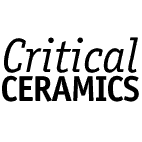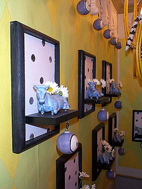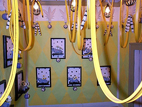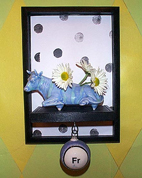





Forrest J. Snyder
Perhaps the most unexpected and most missed exhibit of NCECA 99 was Rebecca Harvey’s Once in a Blue Moon (Acme Art Company, 1129 North High Street, Columbus, OH 43201, 614-299-4003). Notable on many levels, the least of which is that Blue Moon was Ms. Harvey’s first attempt at installation work. Blue Moon adds to the mystery and confusion surrounding its namesake. Further, this work transforms the phrase into something once malleable, now solid, hinting at both the concrete and abstract nature of our lives. At the heart of Once in a Blue Moon are work, play, fact, fiction, science, and myth. The event unfolds in the much coveted bathroom space at Acme Art Company.
In this year, there has been much talk of lunar anomalies. As Harvey says in her artist’s statement, “The lunar cycle lasts about 29.5 days. So, once in a blue moon - every thirty-three months on average - two full moons appear in a calendar month, the second of which is called a blue moon.” Philip Hiscock of Sky & Telescope continues:
The term “blue Moon” has been around a long time, well over 400 years, but its calendrical meaning has become widespread only in the last 20 years.
In fact, the very earliest uses of the term were remarkably like saying the Moon is made of green cheese. Both were obvious absurdities, about which there could be no doubt. “He would argue the Moon was blue” was taken by the average person of the 16th century as we take “He'd argue that black is white.”
The concept that a blue Moon was absurd (the first meaning) led eventually to a second meaning, that of “never.” The statement “I'll marry you, m'lady, when the Moon is blue!” would not have been taken as a betrothal in the 18th century.
Thus, as a scientific phrase, blue Moon is of recent origin, it still maintains its elder and altogether different root - ‘rare’ with a touch of the absurd. Play becomes science.
A second theme in Blue Moon is Harvey’s use of the Periodic Table of the Elements. As she explains, “Dmitri Ivanovich Mendeleev (1834 - 1907) was born in the Siberian town of Tobol’sk where his father was a teacher of Russian Literature and Philosophy. The youngest of 17 children, [Mendeleev] was considered a less than outstanding student... While he was working on a textbook on inorganic chemistry, Mendeleev organized his materials [on cards] into terms of the families of known elements that displayed similar properties... Mendeleev arranged the cards on a table in order of ascending atomic weight, grouping elements of similar properties together in a manner not unlike the card arrangement in his favorite solitaire game, Patience.” Science becomes play.
In very basic description, the work consists of a constructed drop ceiling hung with caged utility lights illuminating the room and the ceramic objects within. Also from the ceiling hung tripartite black and white striped ceramic sausages (for lack of a better description); along the top and bottom of each hand painted wall, Harvey hung cast fleur-de-lis from which hung pool ball sized spheres, moons?, with the symbols of the elements decalled onto them. Finally, spaced evenly along the middle of the four walls were blue striped cows, each sitting on a black shelf in a black frame with white black-dotted background. Out of the back of each bovine, sprouted three daisies.
The boundaries and links between these various themes merged and vague. The artist admits as much in her statement, “This bathroom came into being from a vague notion, a combination of the periodic table and a cluster of blue cows. The cow mold appeared in my studio previously, it became a creamer named anomaly, but the logic behind the planned juxtaposition was hazy at best.” Does the often recited Mother Goose rhyme, The Cat and the Fiddle, have a place in this work?
Hey, diddle, diddle,
The cat and the fiddle,
The cow jumped over the moon.
The little dog laughed
To see such sport,
And the dish ran away with the spoon.
Are the tripartite striped sausages scientific descriptions of electron clouds? Could then lead to a greater object above, thus placing the viewer under or inside a magic space. These spheres could be scientific notation, concise and straight forward. For that matter, they could be a child’s play things or moons or the very notion of matter, enlarged atoms for our inspection. Adult. Child. Work. Play.
Curiously, many of the periodic moons hang from fleur-de-lis, an architectural element representing an iris flower. The iris, of course, has a larger place in mythology. In Greek mythology, Iris is the goddess of the rainbow and a messenger of the gods. Science lofted by myth.
Finally, the cows. These cows are resting down on their elbows and bellies, chewing their cud. As their jaws grind, their eyes slowly blinking, the ponder us as we look at them. For us, the western civilized world, the lowly bovine is not much more than a biological food factory. Sure, at one point in our distant past, raising and keeping a cow probably meant the difference between life and death (or at least disease), but those days are long past. The cow is almost an abstract to many of us; often our only contact is our observation of herds while we whiz by on the interstate. We only speak of them to our young children in nursery rhymes. Still, some African cultures rely heavily on cattle as currency and sustenance. The Hindu culture treats the bovine similarly. It is such an important creature as to be nearly free to wander largely where it likes. The Hindu traditions bring us back to our blue Moon. In their calendar, in each month which features two new moons, another month is added.
Rebecca Harvey creates a strange mix of nursery rhyme playfulness (one wonders if Harvey’s young child prompted some of this), serious scientific study (she’s a faculty member at Ohio State University), and workman like utility (she's a potter at heart). So, here one sits on the throne contemplating scientific fact and fun childhood fiction. Stare left. Look right, down and up. Puzzle Once in a Blue Moon.


